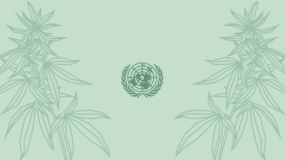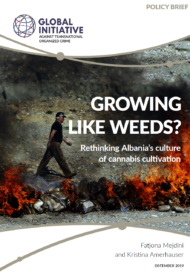Posted on 31 Mar 2023
Cannabis legalization and the classification of coca leaf were among the most prominent topics of discussion at the 66th session of the UN Commission on Narcotic Drugs (CND). In a context of shrinking consensus among member states, there is a clear need for expert-led discussion of illicit drug markets and drug policies as the 2024 policy review looms.
The 66th session of the UN’s annual CND, which took place in Vienna during the week of 13 March, highlighted many of the continuing trends in global drug policy while bringing new issues to the fore. Particular attention was given to cannabis legalisation, the classification of coca leaf under international law, sustainable development-based approaches to drug policy, the ‘southern route’ out of Afghanistan, and civil society engagement and human rights.
The session was chaired by the Colombian ambassador in Vienna, Miguel Camilo Ruiz Blanco, and its main political outcome was to pave the way for next year’s review of international drug policy commitments, through the agreement of a modalities resolution for the meeting. Colombian support for Bolivia’s call for coca leaf to be removed from the UN’s drug control treaties was the highest-profile intervention of the week. Changing drug markets, politics and priorities in Colombia and across Latin America (and the broader Americas) were therefore centre stage. At the same time, much-needed attention was given to illicit drug markets and their harms in other regions – in particular, Afghanistan and the ‘southern route’ to East and southern Africa.
The CND also agreed to place seven new substances under international control, and adopted three substantive resolutions (on handling of synthetic drugs, ‘alternative development’ and information sharing in support of the international drug control system). The session therefore maintained the status quo on how to approach international drug policy, through ongoing scheduling of substances under the drug conventions (i.e. requiring regulations and prohibition), resolutions aimed at international cooperation and an ongoing recognition of the drug conventions’ central role. Indeed, the modalities resolution adopted maintained that the drug conventions are ‘the cornerstone of the international drug control system’.
The speeches made in plenary and side events demonstrated the increasing rhetorical gap between the formal decisions taken during the CND and the reality of national drug positions. The growing list of countries that have relaxed cannabis legislation in recent years – including major economies such as Canada and the US, and Latin American and African states that have introduced reforms for non-medical and non-scientific uses – has challenged the coherence of the UN’s regime. Perhaps unsurprisingly, the International Narcotics Control Board (INCB), charged with monitoring implementation of the various treaties, came out strongly against broad legalization, with a negative assessment of cannabis legalization published in its 2022 annual report. The INCB maintains the view that cannabis legalization, for non-medical or non-scientific use, contravenes the conventions, and claims that legalization has not achieved the aims set out by governments of reducing criminality and generating tax revenue. Others challenged this assessment, highlighting that it is either too early to tell or that the harms of prohibition outweigh any societal benefits.
Given these ongoing tensions, it was striking that Bolivia and Colombia chose this CND to call for the removal of international restrictions on coca leaf. Like cannabis, coca leaf has widespread ramifications for the drug conventions, given its integral role in the 1961 convention text. Yet Bolivian vice president David Choquehuanca made an impassioned plea for the ‘liberation’ of the coca leaf.
Cannabis and coca are set to be points of discussion at next year’s mid-term review of UN drug policy commitments, as required under the 2016 UN General Assembly Special Session on Drugs (UNGASS). Also needed is a thorough debate on the role of addressing illicit markets in shaping drug policy. As attitudes have slowly but now fundamentally shifted in Europe and Latin America towards a more human rights- and health-centred approach, it remains to be seen how countries will change their approach to tackling illicit drug trafficking, and how to determine whether new policies are having the intended effects on illicit markets.
Meanwhile, as Ghana (the expected chair for next year’s CND) is set to preside over the mid-term review in 2024, the issue of cocaine-dominated economies in West Africa presents another front in the debate. Also of importance are the illicit drug markets coming out of Afghanistan (being without an internationally recognized government), as these present major challenges for the region and the international community, and trade routes continue to cause havoc in communities of the East African coast and the Indian Ocean littoral.
The GI-TOC helped brief member states and civil society on these challenges at three side events. An event on the future of illicit economies in Afghanistan was organized by the UN Office on Drugs and Crime (UNODC), with the support of the London School of Economics and the University of Birmingham. The GI-TOC partnered with the UK Government, the UNODC and others to present its latest research and responses to drug markets along the ‘southern route’, including through the launch of the Eastern and Southern Africa Commission on Drugs. Together with the International Society of the Study of Drug Policy, the GI-TOC showcased its research on latest drug trends and related illicit markets across North Africa. All three events tackled the ongoing societal harms and challenges facing countries as a result of illicit drug markets and their associated effects.
The week’s discussions raised some pertinent questions, including whether we have the necessary evidence and understanding to mount more effective responses to drug markets in communities where a greater number of people are using drugs such as heroin and methamphetamines, and how to apply more human-centred responses in contexts with varying levels of political support and willingness for change.
The interaction between human rights and drug policy is complex, and many have questioned the collateral consequences of the global drug control system on communities and marginalized groups. And despite clear elaboration on the links between sustainable development and drug control in the UNGASS 2016 outcome document, the issue of development and drug control remains fraught. Several states and organizations continue to push for a widening of focus, from a traditional ‘alternative development’ approach to drugs in rural settings to including sustainable development in responding to urban drug markets.
The latest CND showed that this discussion remains embryonic and in need of evidence-led conversations and local initiatives that can demonstrate the value of these approaches. Central to this is the question of how states best respond to transnational organized crime. The global drug control system inevitably contributes to the growth of organized crime around the world through the creation of large illicit drug markets, while traditional ‘war on drugs’ approaches have been widely discredited and are seen as ineffective in managing what is a complex socio-economic problem. These are the questions that the CND is not yet equipped to address, but where civil society and other experts can help guide the discussions. In a contested political space, with consensus on a diminishing range of issues, it is vital that the 2024 mid-term review make use of the widest possible base of expertise.



